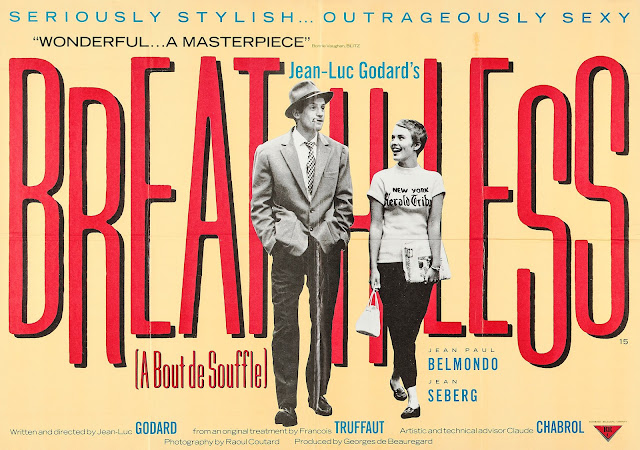French filmmaking that will take your breath away
Tuesday, March 29, 2022
The year 1960 proved a pivotal one in film history, seeing the release of two seminal works that forever changed the landscape of cinema with their revolutionary approaches to narrative storytelling and stylistic editing choices: Psycho and Breathless. Our CineVerse group explored the latter last week, sharing many opinions, perceptions, and truisms, as summarized below (to listen to a recording of our group discussion, click here).
How would this film have been groundbreaking, daring, unexpected, and innovative upon its 1960 release?
- It is one of the seminal works of the French new wave, which started with François Truffaut’s The 400 Blows and Alain Resnais’ Hiroshima Mon Amour. This wave sought to reinvent film as an auteurist movement that broke with standard filmmaking conventions, including the typical rules of editing.
- Breathless is primarily remembered for its revolutionary jump cuts. The edits between shots are not done seamlessly or following continuity; shots are juxtaposed abruptly, with brief ellipses in time occurring between the cuts.
- Godard’s film is also characterized by its extremely long shots, numerous close-ups (comprising around one-fifth of the shots), and a tireless mobile/tracking camera through the streets of Paris and into various interiors that employ a “you-are-there,” cinema verite, documentary-like aesthetic and approach.
- As at the end of The 400 Blows, a major character breaks the fourth wall and looks directly into the camera (Patricia, in the last shot).
- Perhaps what is most memorable about Breathless is its tone and style.
- Roger Ebert wrote: “what is most revolutionary about the movie is its headlong pacing, its cool detachment, its dismissal of authority, and the way its narcissistic young heroes are obsessed with themselves and oblivious to the larger society… Modern movies begin here, with Jean-Luc Godard's "Breathless" in 1960. No debut film since "Citizen Kane" in 1942 has been as influential… There is a direct line through "Breathless" to "Bonnie and Clyde," "Badlands" and the youth upheaval of the late 1960s. The movie was a crucial influence during Hollywood's 1967-1974 golden age. You cannot even begin to count the characters played by Pacino, Beatty, Nicholson, Penn, who are directly descended from Jean-Paul Belmondo's insouciant killer Michel.”
- Per Criterion Collection essayist Dudley Andrew: “Breathless is indeed a hallmark of modernist cinema…Godard forced the kind of confrontation between high and popular culture that energized the art world. Ingeniously, he scripted a chiasmus where an American girl is left to guard traditional artistic values (Bach, Chopin, Mozart, Renoir, Matisse, Picasso, Faulkner) while the Frenchman, a reader only of newspapers, is a connoisseur of cars, particularly American ones. Cinematic modernism reaches a plateau when, while a crowd cheers Eisenhower and de Gaulle along the Champs-Élysées, the characters give the slip to the cops by hiding out in a movie theater that is playing Budd Boetticher’s Westbound…The dramatic heat produced when distinct national cultures (both high and low) rub up against each other energized not just this corrosive movie but an entire movement, vigorous and critical: the nouvelle vague.”
- Critic Nathan Heller of Slate wrote: “Breathless is an orchestrated dialogue between two worlds—a world of stylized Hollywood romanticism and the everyday world of banal, uncinematic life. It’s Godard’s careful counterpoint between these two styles that helped him tease out a “French attitude” and gave the movie its relentless drive… The result was new and striking not so much for its documentary flavor—the vérité approach was amply fleshed out by the time Godard began—but for its dissonance: the conflict between what Breathless purported to be (an exotic Sin City flick) and what it delivered (scenes from commonplace Paris)… He was trying to make a film that, at each turn, broke with his culture’s notion of what French movies were supposed to be. Where the dominant screen style had moral overtones, Breathless is breezily amoral, at least until its final moments.”
Themes
- Carpe diem (live for today with little regard for the future) and “live life dangerously to the end,” which is the tagline to the poster shown for the movie Ten Seconds to Hell.
- Lovers on the run.
- Betrayal: Patricia secretly turns in Michel.
- Existential angst. Consider Patricia’s wavering about Michel and her choices. She asks if she is unhappy because she isn’t free or is she not free because she is unhappy. She can’t decide whether or not she wants to be with Michel. Her conundrum embodies a central tenet: Love can have a push-pull force that attracts and repels. Consider that her betrayal of Michel is apparently a self-test to decide if she truly loves him or not, not a moral decision based on ethics.
- A search for identity. Who is Michel really, other than a wannabe movie gangster who tries to pattern himself after Bogart but demonstrates how bad he is as a criminal evading the police and trying to collect money. And who is Patricia? An American in Paris trapped between two worlds: the allure of romantic love tethered to danger and excitement and an otherwise ordinary exchange student trying to make a living.
- Contradictions in character. Michel says, "Being afraid is the worst sin there is." However, he runs away from the authorities at the end of the film and, earlier, when asked why he killed a cop, he says he was scared.
Similar works
- The 1983 remake of the same name
- Bonnie and Clyde
- The 400 Blows
- In a Lonely Place
- Pierrot le Fou
- Vivre Sa Vie
- Jules and Jim
- Camus’ The Stranger
Other films by Jean-Luc Godard
- Masculine-Feminine
- Contempt
- Pierrot le Fou
- My Life to Live
- Sympathy for the Devil




